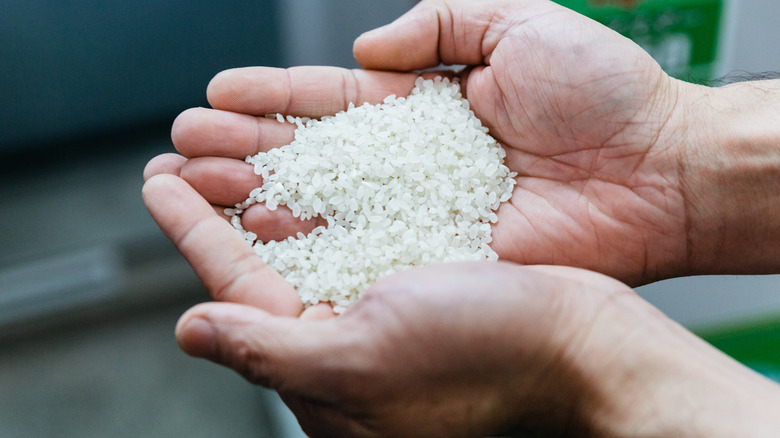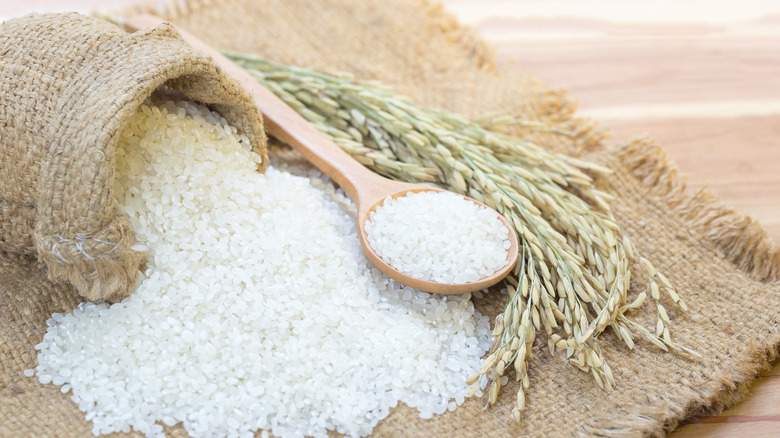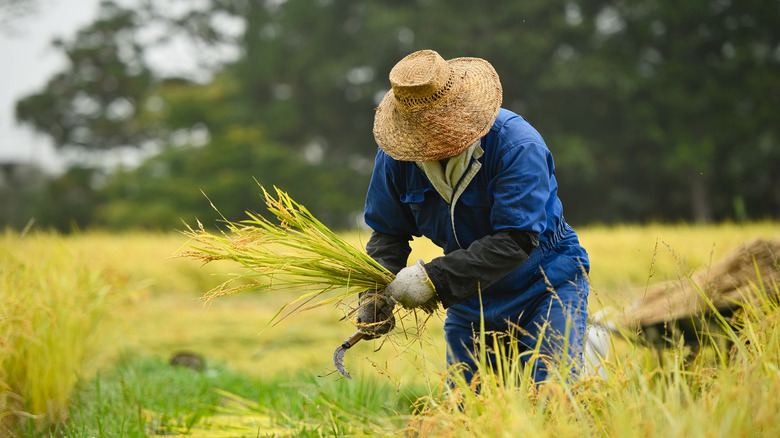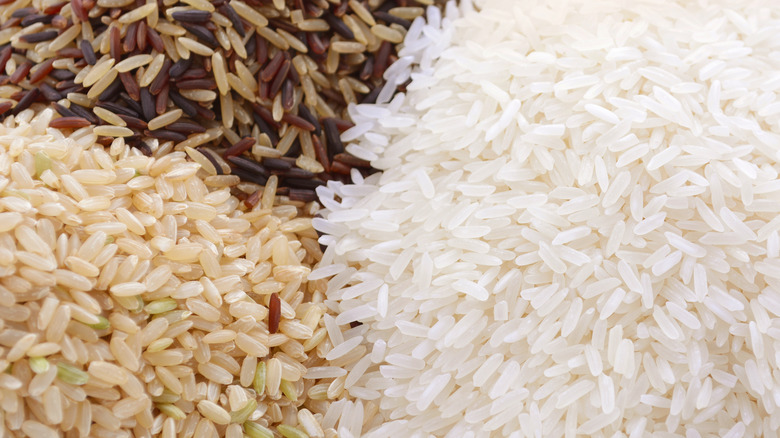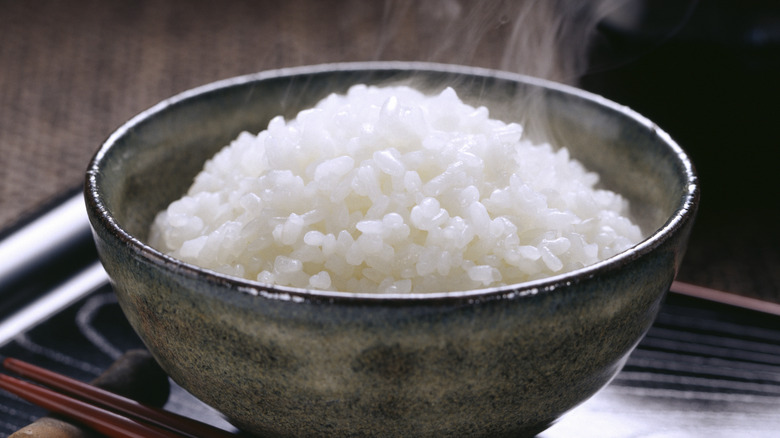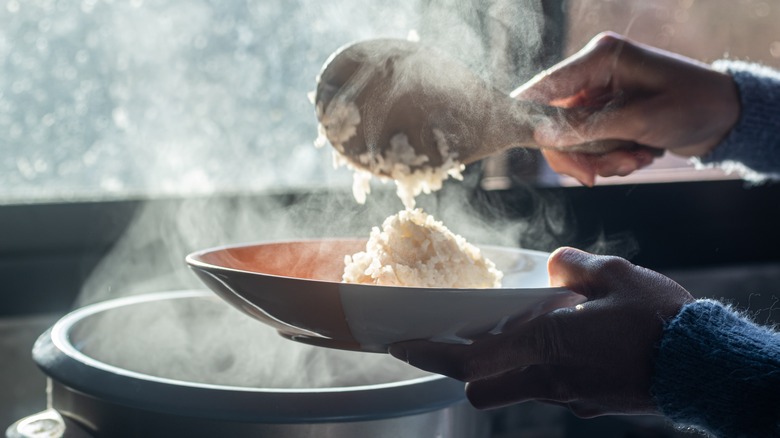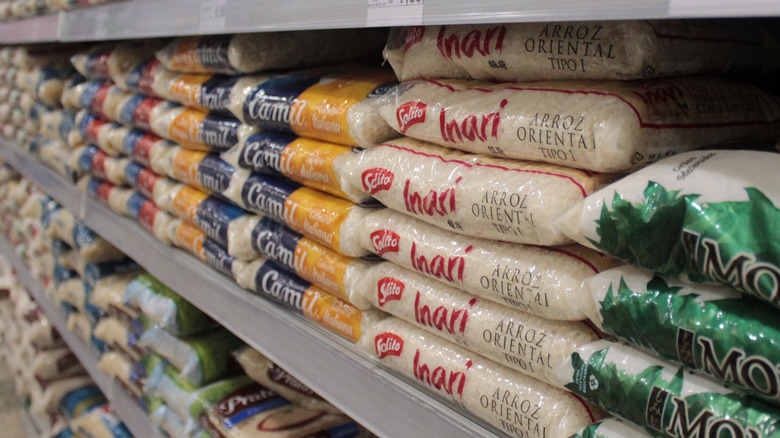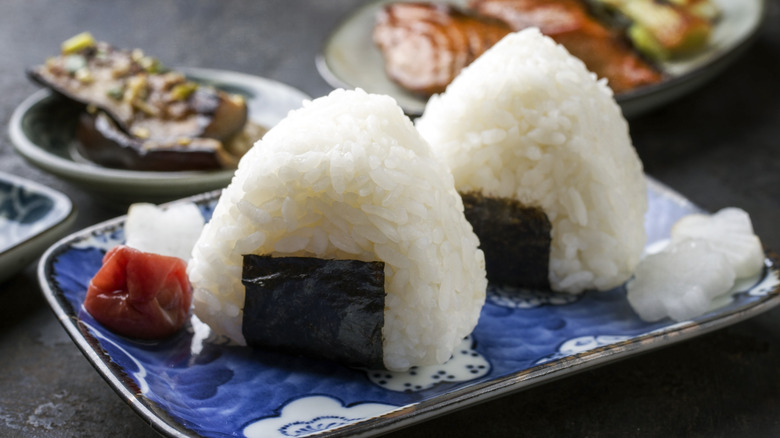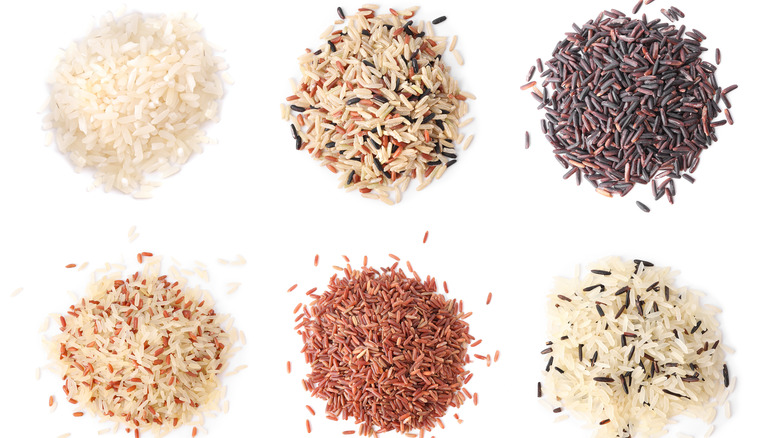What Makes Japan's Koshihikari Rice Unique?
We may receive a commission on purchases made from links.
One cannot think of Japanese cuisine without thinking about that all-important rice (Oryza sativa). The grain, called "kome" in Japan, has been so integral to the Japanese way of life that in feudal times it was used as currency. While it is commonplace to find your bowl filled with rice in Japan, kome is also used to make flour, alcohol, and vinegar. In the Japanese diet, you have such staples as gohan (translated to "cooked rice" or "meal"), mochi, and, of course, sushi, per Japan-Guide.com. Rice cannot be removed from the Japanese identity in the same way pasta cannot be removed from the Italian identity. They are integral components of the way life is lived in their respective countries.
However, there is one rice that reigns supreme in Japan. It's a rice that Taste Atlas describes as soft, chewy, and extremely sticky, making it perfect for some of Japan's most famous dishes. It is a crossbred variety of rice called Koshihikari and it stands as the most grown and most consumed rice in all of Japan.
What is Koshihikari rice?
Koshihikari is a short-grain rice developed in Japan after World War II. Rice itself has been a staple of Japanese cooking for far longer than a few decades, however. According to an essay in The Rice Journal, rice was introduced to Japan some 2,000 to 3,000 years ago by way of the Yangtze River Basin in China. The grain has been cultivated and beloved by the Japanese people ever since. Japan's experimentation with crossbreeding rice began in earnest in 1921. Several hundreds of rice varieties were developed to help combat certain types of plant-based diseases. Among the new varieties developed in the aftermath of World War II was the Koshihikari.
Koshihikari rice quickly took off as a rice of superior quality and popularity, reaching its largest cultivation level in 1979 and remaining the No. 1 produced rice in Japan ever since. In 2016, it was recorded that 535,000 hectares — that's equivalent to 1,322,013 acres — across Japan were dedicated specifically to the growing of this rice. Koshihikari is also grown in certain regions of California, Australia, and China. Its sticky consistency and chewy texture are what have kept it so popular in Japan for the last several decades.
How was Koshihikari bred?
Koshihikari is the result of a special crossbreeding effort that began in 1944. Japanese rice breeders were experimenting with how to better a cultivar called Nourin No. 1 in order to reduce its risk of rice blast disease. They crossbred Nourin No. 1 with Nourin No. 22, which at the time was the cultivar with the strongest resistance to rice blast. Several years of tweaking and further experimentation led to the development of Koshihikari, which was registered with the Japanese Ministry of Agriculture, Forestry, and Fisheries in 1956 (via Taste Atlas & The Rice Journal).
As a result of this development, Koshihikari was disseminated throughout the islands of Japan. The rice is both cold hardy and relatively resistant to pre-season sprouting, making it an ideal crop to be grown in both the northern and southern prefectures of the country. Unfortunately, despite its popularity and its weather tolerance, Koshihikari is still quite weak when pitted against rice blast disease. Despite being developed to resist the blast, Koshihikari, while having some resistance genes, is still very susceptible. However, the overall popularity of the rice, as well as its high quality of flavor and prized stickiness means that it is still the most cultivated throughout Japan, despite its pitfalls.
Koshihikari vs. long-grain vs. medium-grain
There are three different grain classifications to take into consideration when it comes to rice: long, medium, and short. Long-grain rice is very easy to spot, owing to its long, thin shape. According to Just One Cookbook, long-grain rices are four to five times longer than they are wide. When cooked, they turn fluffy while still remaining firm. Some examples of long-grain rice are basmati and jasmine. Medium-grain rice is similar to long-grain in that it is still longer than wide, but only two to three times as much. An excellent example of medium-grain rice is arborio, which is used for making risotto.
Short-grain kinds of rice, of which Koshihikari is one, are the stoutest among rices. They are short and plump and have a high starch content which allows them to stick together without dissolving into gruel. Koshihikari sits in the category of super premium short-grain rice because of its aroma and consistency, per SushiFAQ.com. Other Japanese short-grain rices listed by Just One Cookbook include uruchimai, which is used for making onigiri (rice balls), and mochigome, which is the sweet rice used for making mochi.
What does Koshihikari taste like?
Koshihikari is known throughout Japan for its high eating quality, which is defined by its taste and texture. We've explained how the Japanese have a fondness for sticky, chewy rice, and Koshihikari has these two qualities in abundance. However, it's a taste that always keeps people coming back for more. Koshihikari has a natural sweetness that is unrivaled by any other rice. SushiFAQ.com describes Koshihikari as the "single malt scotch" of rice, saying that while it may not be as widely known outside of Japan, the quality of the flavor contributes to the nuances of the foods it can be paired with.
Koshihikari maintains its consistent, sticky sweet flavor whether it is served hot or cold. Even adding additional flavorings, like seaweed or the vinegar required for sushi, doesn't do much to alter the sweetness of the Koshihikari, per the Chopstick Chronicles. Japanese rice does come in brown or multigrain varieties, but these are not considered to be anywhere close to as delicious as traditional white rice, of which Koshihikari is king. In spite of their lack of nuanced flavor, brown and multigrain rice are nevertheless gaining some kind of recognition in Japan owing to the higher nutrient and vitamin content found in them (via Japan-Guide.com).
How to cook with Koshihikari
The Japanese method of cooking rice is treated, as so many other things are in their culture, as something that needs to be mastered over years and years of dedicated work. Outdoor Chef Life explains this mentality very well in a video on YouTube. Rice is something to be taken seriously, especially varieties as prized as Koshihikari. So, entering, or at least understanding, this mindset may help you when it comes time for you to cook Koshihikari at home.
An important rule to remember when cooking rice Japanese style is that the ratio of water to rice is 10%-20% higher than a standard 1:1 ratio. To make things simpler for U.S. cooks, that can be increased to a 1:1.25 ratio of rice to water, meaning 1 ¼ cups of water for every cup of rice. You'll want your Koshihikari to come out tender and sticky, so you'll need to first rinse the rice under cold water to remove any exterior impurities. You then soak the rice for up to 30 minutes in order to revive its texture, before placing it in a heavy bottom pan with a tight-fitting lid, cooking it, and letting it rest for up to 10 minutes so it can finish steaming. Then fluff it to get rid of any excess moisture (via Just One Cookbook).
Where to buy Koshihikari
As with most specialty food items, the closest you're going to get to the real deal — i.e. as you would find it in Japan — would be to go to a Japanese or Asian market. These places specialize in importing products made overseas. So, if you want authentic Japanese rice shipped straight from Japan, check and see if there is a specialty market near you. However, most major grocery stores, like Walmart or Whole Foods, carry brands that you'll find in the Asian aisle (via Just One Cookbook).
The stuff you're likely to find in your local grocery store is Koshihikari rice which has been grown in California. Brands like Tamaki Gold, Shirakiku Rice, or Lundberg Family Organic Farms Sushi Rice are all top-quality domestic brands that are equivalent to Japanese brands. Be sure to look for the label "shinmai." This means "new crop" in Japanese and is an indicator that you are getting the freshest rice. Here's the label in kanji if the brand you're looking at is not in English: 新米.
Koshihikari nutrional facts
There are a few nutritional facts you'll want to consider before purchasing Koshihikari rice. The first thing you want to be wary of is the level of arsenic in your rice. This is nothing to be majorly concerned about, but rice does have a natural amount of arsenic, as apples do. The bran of the rice is what holds the most arsenic, which is why you want to soak and rinse your rice for extended periods, as well as buy from brands with good reputations, such as those listed above, per Just One Cookbook.
The standard nutritional facts for Koshihikari are the same as most other white rices. They are free of gluten, cholesterol, sodium, and sugars. This makes them an excellent carbohydrate choice for regaining energy, per Nature's Best Belfield. However, if you're looking for more nutrients and vitamins, you won't find them in Koshihikari. Brown rice is a much better choice for anyone looking for a rice that contains high amounts of fiber, vitamins, and nutrients and is good for diabetes.
Other varieties of Japanese rice
Every year, the Japanese Grain Inspection Association does a taste test of different brands and varieties of rice. According to Nippon, as of 2019, 55 brands of Koshihikari have gained a Special A designation, which is the highest ranking the JGIA can bestow. Koshihikari rice is split into categories, or generations. The first generation is straight Koshihikari, while subsequent generations are crossbred with other rices, getting farther and farther away from the original, as in a family tree. Some second-generation rices are Akitakomachi, Hitomebore, and Nasuhikari, all of which are ranked as Special A.
Other types of rice, as indicated by The Rice Journal – such as Ichihomare, Shinnosuke, and Tsuyahime — are all new cultivars of rice that have been developed in Japan, the idea being that they will eventually replace Koshihikari so as to create a lasting and diverse rice crop throughout the country. However, as the Japanese people still vastly prefer Koshihikari over any other type of rice, it is going to be a long time before any other variety takes over as top rice.
